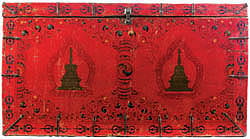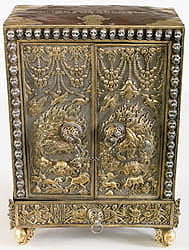Wooden Wonders: Tibetan Furniture in Secular and Religious Life
November 13, 2004 – February 13, 2005
“The Tibetan style of furnishing is elaborate and luxurious…
when it is carried out with taste it has a bold, barbaric fascination that can hardly be excelled.”
So the Italian scholar Fosco Maraini characterized the interior of Tibetan houses and monasteries during his travels on the plateau in the late 1930s. Within twenty years the world he so vividly described would be swept away in the tide of the Chinese invasion and the later Cultural Revolution. Yet while so much of Tibetan material culture was lost forever, some furniture has survived and re-surfaced in the 21st century as one of the most fascinating new subjects in Tibetan design and aesthetics.
USC Pacific Asia Museum is pleased to present the first exhibition of its kind, Wooden Wonders: Tibetan Furniture in Secular and Religious Life on display from November 13, 2004 – February 13, 2005. This groundbreaking exhibition will explore the uses of traditional Tibetan furniture in domestic life and religious institutions and how this reflects the evolving lifestyles, traditions and beliefs of the Tibetan people. Many of the furnishings of a traditional Tibetan home or monastery have both a practical and a symbolic or protective function. The forms and functions of furniture such as trunks, altar tables and storage cabinets, and their decoration, including Buddhist symbols and Buddhist protective deities, inform us about the people of Tibet over the last 800 years. Often, furniture was a vehicle to gain merit, whether it was given as offerings to monasteries, or used to make offerings to various deities in the Tibetan pantheon.
Wooden Wonders will include 148 objects, illustrating the rich variety of traditional Tibetan furniture types from both the secular and religious realms, and from various regions of Tibet. In addition, it will address the materials and construction techniques used to create the furniture and the decorative symbols and motifs on them. Attention will also be given to the decorative influences on the furniture of textiles from India, Nepal, China, and other Asian cultures. Connections between furniture painting, thangka painting and mural painting will also be briefly explored. Institutions such as LACMA, Iris & B. Gerald Cantor Center for the Visual Arts (Stanford) and the Rubin Museum of Himalayan Art (New York) will be involved through loans of furniture and thangka paintings.
The exhibition is curated by David Kamansky, Director Emeritus and Senior Curator of USC Pacific Asia Museum with assistance provided by the exhibit team member Bridget Bray and Dr. Ruth Sutherlin Hayward.
Exhibition Catalog
Because of the groundbreaking nature of this exhibition, USC Pacific Asia Museum is producing a catalog about Tibetan furniture that will examine the tradition from several angles. Encompassing masterpieces of Tibetan furniture design and decoration in all its forms, the 148 exhibits are drawn from the large group of public and private collections in the western United States, the result of an active interest in the preservation and research of this long overlooked Tibetan art form.
The catalogue has been edited by David Kamansky with contributions by David Kamansky, Luca Corona, Camilla Hulse Corona, Jonathan Bell, Dale Gluckman, Ian Alsop, Tony Anninos, John Listopad, Ruth Hayward, Geshe Lobzang Tsetan with Kathleen Kernell, Stephen Markel and Pamela Logan.
This extensive publication seeks to communicate both the aesthetic significance of these exceptional works of art and the important role they have played over the centuries in the daily and spiritual lives of the people of Tibet. The works in the exhibition were selected both for their aesthetic and historical importance. All are illustrated in color, and each is accompanied by details of type, date (with Carbon 14 proof), dimensions and description, of decorations and materials.
Related Programs:
Symposium on Tibetan Furniture
November 13, 2004
We are pleased to work with Occidental College to present a day-long symposium November 13, 2004. The symposium will be an interdisciplinary exploration of Tibetan furniture as a new subject for art history, religious studies, anthropology, Tibetan studies, and other related fields. The nine speakers and four discussants represent a variety of backgrounds and institutions, and include scholars from area universities, practitioners, and collectors, along with USC Pacific Asia Museum staff. The participants are Luca Corona, Dale Gluckman, Dr. Rob Linrothe, Geshe Lobzang Tsetan, Dr. Louise Yuhas, Dr. Robert Brown, Tony Anninos, Dr. Ruth Hayward, Dr. Pam Logan, Dr. David Germano and R. Sreplin Marked. The symposium will take place at the Pasadena Conference Center located at 300 East Green Street fro 8:15am to 6:00pm.
Celebration of Awakening: A One-Day Multi-Cultural Festival of Spiritual Art
November 14, 2004, 10am-4pm
The unveiling of 34 foot high Thangka of Liberation, the largest ever Tibetan thangka (silk tapestry) displayed in North America, followed by performances and talks by spiritual leaders from many traditions. Hosted by Lama Lhanang Rinpoche and Jigme Lingpa Center, with support from USC Pacific Asia Museum Himalayan Arts Council.
Introduction to Tibetan Buddhist Art
November 20, 2004, 12-4pm
Spend an afternoon learning about Tibetan culture through their art beginning with a tour of the exhibition Wooden Wonders: Tibetan Furniture in the Context of Religious and Secular Life, then continue with a talk about the religious arts of Tibet. Class includes a workshop and lunch. Open to teachers only.
Symbols of Transformation on Tibetan Buddhist Art
November 20, 2004, 2-3pm
Gail Maxwell will introduce guests to a wide range of symbols used by the Buddhist art traditions of Tibet. Closely associated with the religious practices of Esoteric Buddhism, these symbols point to the belief that guided visualization can transform and purify human consciousness. Sponsored by the Freeman Foundation.
Authors on Asia: Tibetan Buddhist Life
November 28, 2004, 2pm
With over 200 stunning historic and contemporary photographs, including examples of ancient and modern Tibetan art, this is the first book to gather all the elements of Tibetan Buddhist life. Acclaimed photographer Don Farber has created a superb testament to the beauty, artistry, wisdom and strength of the Tibetan people.
Beyond Suffering and Death: Auspicious Messages on Tibetan Furniture, a Collector’s View
December 4, 2004, 2-3pm
Dr. Ruth Sutherlin Hayward will share an ‘insider’s view’ based on collecting and living with Tibetan furniture since the early ‘90s in Kathmandu when she first saw it.

